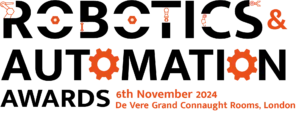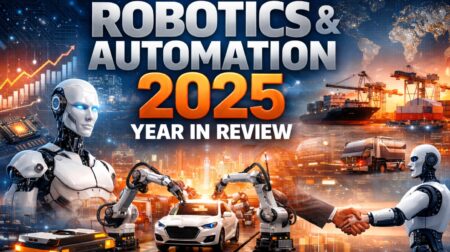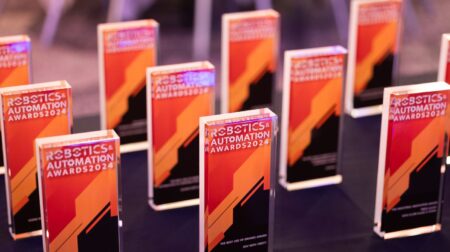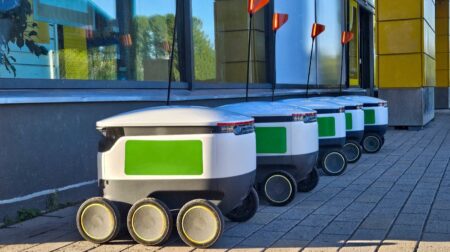Why did you choose to be a judge at the Robotics & Automation Awards 2024?
I chose to be a judge at the Robotics & Automation Awards 2024 because I believe in the transformative potential of these fields to shape the future of industries and society. Being part of this event allows me to engage with cutting-edge innovations and the brilliant minds driving them forward. It’s an exciting opportunity to not only recognise outstanding achievements but also to contribute to the growth and visibility of groundbreaking technologies that can solve real-world challenges. Additionally, I’m passionate about fostering innovation and excellence, and I see this as a chance to inspire and encourage the next wave of innovators
Can you share your background in robotics and automation and how it has informed your judging criteria for the Awards?
In my current role as robotics lead at InnovateUK Business Connect, I work within the public sector to connect businesses and support their growth by leveraging the latest innovations in robotics and automation. My primary focus is helping businesses unlock their potential by identifying and implementing cutting-edge technologies that can drive operational efficiency and success.
With my experience in robotics and a deep understanding of the challenges businesses face, I approach judging the Robotics & Automation Awards with a strong focus on solutions that are not only innovative but also have real-world applications. I believe in the power of robotics to shape industries and help businesses grow, which directly informs my judging criteria.
I evaluate entries based on:
- Innovation: How forward-thinking and unique is the solution? Even if it already exists in the market, what is their unique selling point?
- Technical Excellence: Is the technology well-engineered and capable of delivering results? This means looking into their technical aspect and to see how they are communicating this.
- Real-world Impact: Can this solution solve real industry challenges and support business growth? Have they seen a niche problem to solve?
- Scalability and Sustainability: Is the solution designed for long-term success and adaptability? Can end users easily access the robot?
In my role, I see firsthand how robotics can transform businesses, and I’m excited to highlight solutions that not only push the boundaries of technology but also offer practical value in supporting business growth and addressing industry needs.
What does robotic and automation innovation mean to you?
Robotic and automation innovation, to me, represents the continuous evolution of technology that has the potential to transform how we live, work, and solve problems. It’s about pushing the boundaries of what machines and systems can achieve, improving efficiency, safety, and scalability across industries. Innovation in this field means developing solutions that are not just technically advanced, but also practical, adaptable, and accessible to a broad range of sectors.
More importantly, it’s about creating tools that empower businesses to grow, optimise their processes, and make informed decisions faster. Whether it’s through advanced robotics enhancing precision in manufacturing or automation streamlining workflows in logistics and healthcare, these innovations can drive economic growth and societal progress.
For me, it’s exciting to see how robotics and automation can bridge gaps, solve complex challenges, and create new opportunities—enabling us to rethink traditional ways of doing things and improving outcomes on a global scale.
What recent trends in robotics and automation have you found most exciting or impactful across different industries?
For me it definitely would be collaborative robots (cobots).
Cobots are designed to work alongside humans, making automation accessible to smaller companies and industries where full automation isn’t feasible. Their adaptability and ease of use allow businesses to improve productivity without needing highly specialised robotics expertise. Cobots are particularly transformative in manufacturing, assembly lines, and warehousing. And now we can start to see them being used in other industries such as hospitality and healthcare. Who knows what other applications exists for these types of robots. I’m very excited to see what the future holds for more use of these robots especially when they are integrated with AI to become smart machines.
We are getting in the era of AI and this has been the biggest topic of conversation. AI-driven robots can now analyse data, recognise patterns, and make decisions in real time, making them ideal for industries like healthcare, agriculture, and logistics, where precision and efficiency are critical.
These trends not only exciting because of their technical advancements, but also because they’re reshaping industries by enhancing productivity, lowering costs, and solving real-world problems. The convergence of AI, robotics, and automation is creating smarter, more flexible systems that are set to define the future of work across multiple sectors. I am looking forward to seeing what other impacts AI-driven cobots would make across other industries as the public start to understand that robotics and automation are not taking their jobs, but transforming how we work with the aim of making human work life more efficient.
How do you see robotics and automation transforming various industries, such as healthcare, manufacturing, and agriculture?
Robotics and automation are poised to profoundly transform industries like healthcare, manufacturing, and agriculture by increasing efficiency, precision, and scalability.
In healthcare, robotics and automation are revolutionising ,making it more efficient, precise, and accessible. We have seen this with the advancement in surgical robots where robotic-assisted surgeries are used for minimally invasive procedures with higher precision, resulting in quicker recovery times, fewer complications, and reduced human error. Looking back a few years ago, this was seen as crazy. But now it has become the norm that you can even get heart surgeries without having a big scar run through your chest as the doctors would need to open up your chest allowing patients to recover quickly. Not only this, but Robots are also playing a significant role in physical therapy and rehabilitation, helping patients regain movement and strength, while advanced robotic prosthetics are improving mobility for individuals with disabilities. My vision is to see robotics prosthetics used by the public in sports events like the Paralympics.
In manufacturing, we have the government supporting the development of smart factories with the launch of programmes such as the Made Smarter Innovation, which allows UK businesses to incorporate AI and robots in their factories. Especially with the UK regulation for industry 4.0, robotics and automation has enabled the UK to achieve it.
Post Covid-19 and Brexit, the UK agriculture sector faced a number of significant challenges and transformations, this included labour shortages and disruption to supply chains. The pandemic highlighted vulnerabilities in the food system, prompting a push toward more resilient and sustainable farming practices such as the use of robots and automation to transform the way we grow, manage, and harvest crops, making the sector more efficient, sustainable, and data-driven. Automation systems being used in indoor vertical farms to optimise crop production in controlled environments, has minimised the need for land and water, making it a more sustainable method of farming in urban areas. Who is to say that moving forward we wouldn’t have individuals growing their products at home without the need of an experienced farmer?
As robotics and automation continue to advance, we’ll see even greater transformations across industries. Ultimately, these technologies are driving innovation, enhancing productivity, and improving the way we live and work.
In your opinion, how will the role of judges in awards like this evolve as the fields of robotics and automation continue to advance?
As robotics and automation become more sophisticated, the expectation for tangible, real-world impact will grow. Judges will need to shift from evaluating purely technical achievements to assessing how innovations address critical industry challenges, improve efficiency, and contribute to sustainability. The role will evolve from recognising technical brilliance to ensuring that the technology can be scaled, adopted, and integrated effectively in various sectors. This means that there will be an increased focus on real-world applications and impact.
In addition to this, with advancements in AI, autonomous systems, and robotics, ethical considerations such as safety, privacy, and fairness will become more central. Judges will need to evaluate not just the technical capabilities of solutions, but also how they align with ethical standards and societal norms. This will include assessing how technologies protect user data, avoid bias, and ensure welfare of employees. The role of judges will involve a deeper understanding of the ethical implications of the solutions they’re evaluating. The UK launched the AI standards hub that will set the guidelines for AI including AI that is used in Robotics. This means judges will have a greater emphasis on ethical considerations.
These judges will need to stay adaptable, informed, and collaborative, ensuring that they recognise innovations that not only push technological boundaries but also have a lasting positive impact on industries and society.
 Innovations and achievements in robotics across many sectors will be highlighted and celebrated at the second annual Robotics & Automation Awards on 06 November 2024 at De Vere Grand Connaught Rooms in London. Visit www.roboticsandautomationawards.co.uk to learn more about this unmissable industry event – and to book your table!
Innovations and achievements in robotics across many sectors will be highlighted and celebrated at the second annual Robotics & Automation Awards on 06 November 2024 at De Vere Grand Connaught Rooms in London. Visit www.roboticsandautomationawards.co.uk to learn more about this unmissable industry event – and to book your table!









